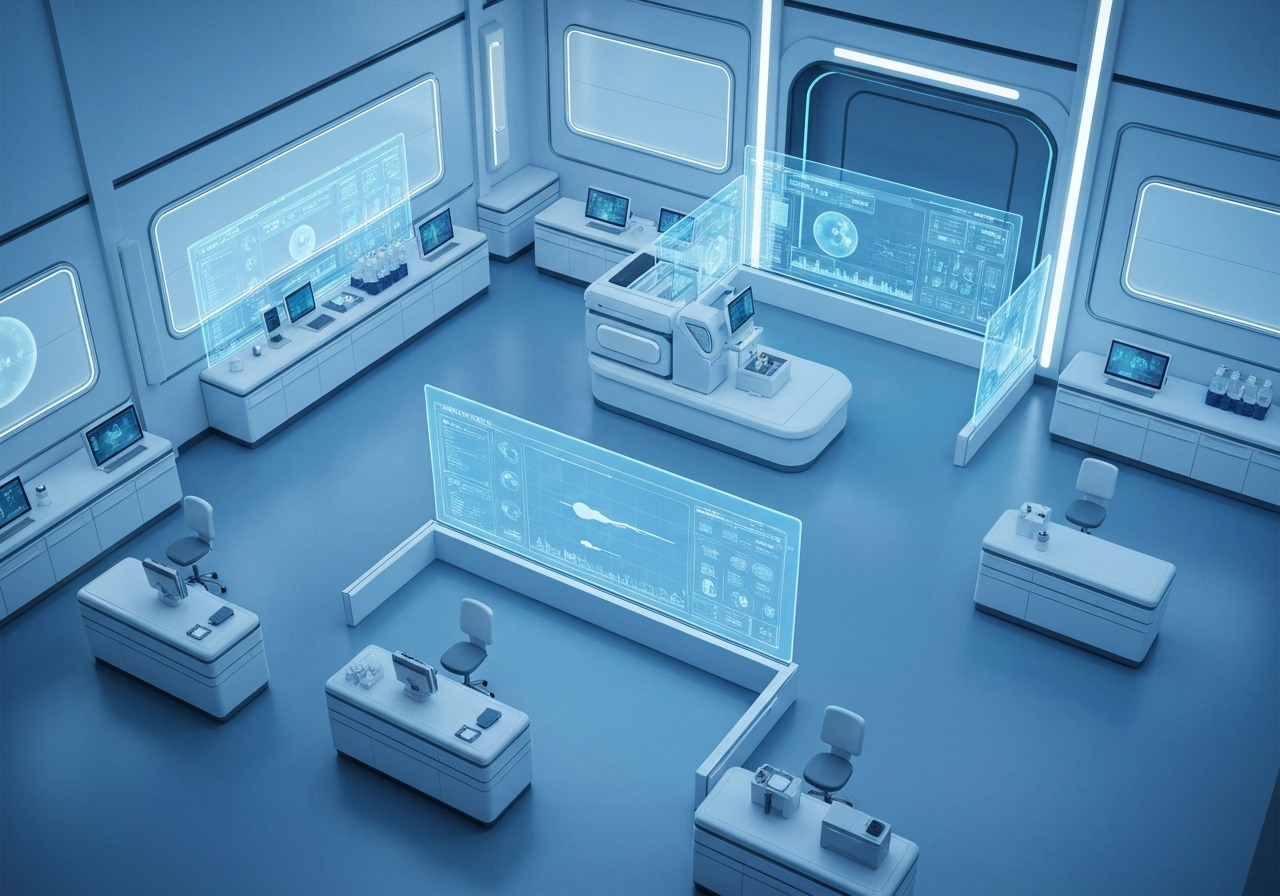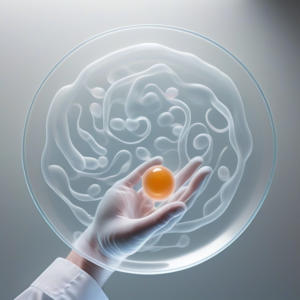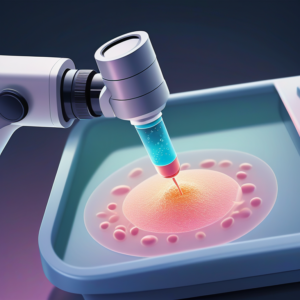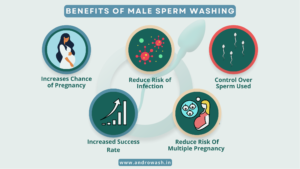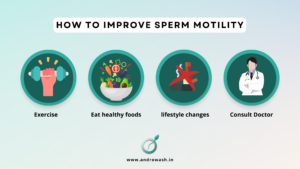Key Highlights
- Semen preparation is a crucial step in assisted reproductive technology (ART) to address male infertility.
- Accurate sperm diagnosis and selection directly influence the success of procedures like intrauterine insemination (IUI).
- Conventional sperm selection methods include swim-up, density gradient centrifugation, and simple wash techniques.
- Advanced diagnostics like sperm DNA fragmentation testing help identify issues that affect sperm quality.
- Modern methods like microfluidics, MACS, and AI-based analysis are transforming sperm selection.
- Improving sperm preparation techniques can lead to higher pregnancy rates and better outcomes.
Introduction
Male infertility is a common challenge for many couples trying to conceive, affecting up to 15% of couples. Assisted reproduction offers effective solutions, but success often depends on sperm quality. Preparing and selecting the healthiest sperm is a critical first step in treatments like IUI and IVF. Innovative sperm diagnosis techniques are essential for separating the best sperm cells from the semen sample, which can significantly enhance the chances of a successful pregnancy. This process addresses male infertility by ensuring only the most viable sperm are used.
Overview of Sperm Diagnosis in Assisted Reproductive Technology (ART)
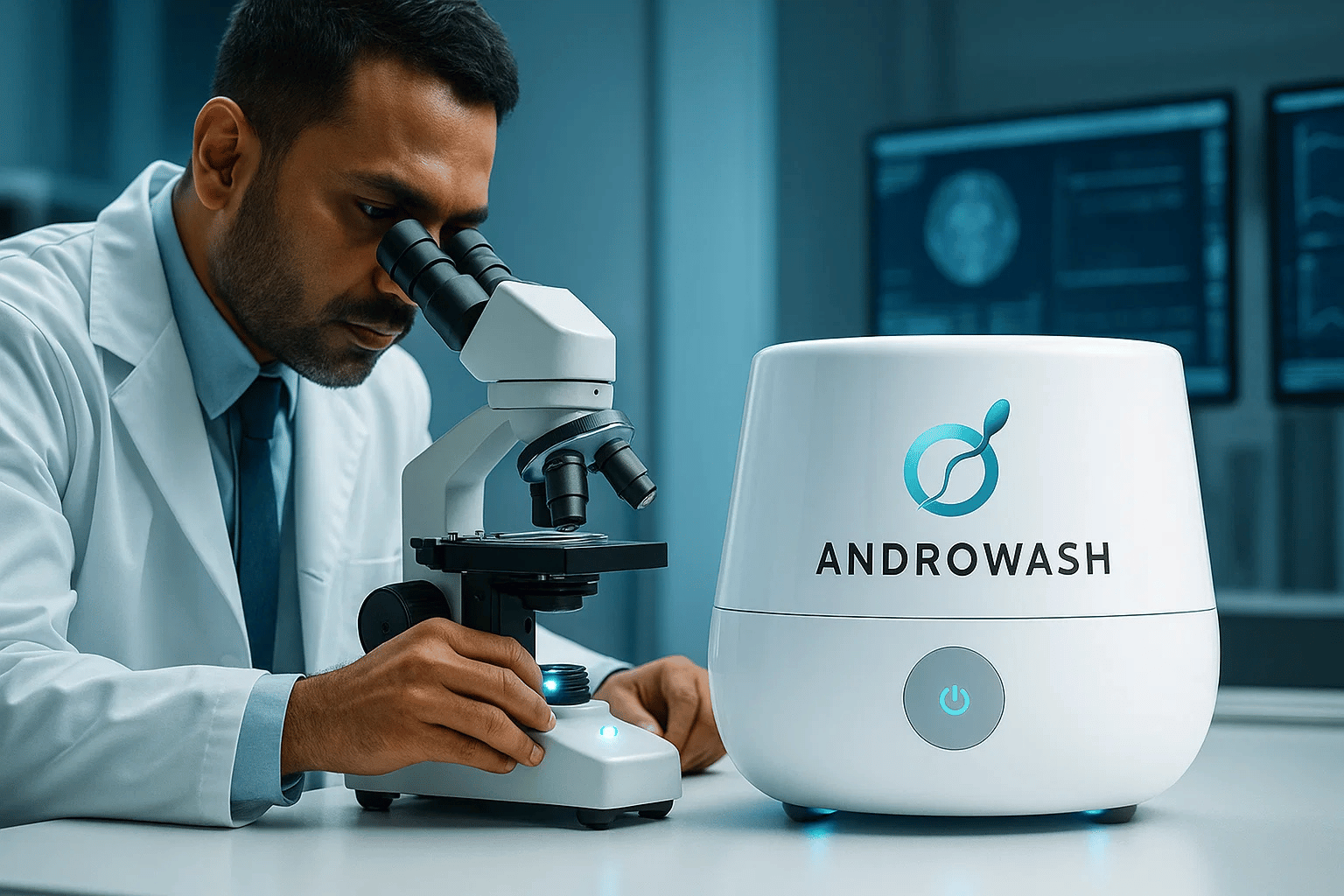
Sperm diagnosis in assisted reproductive techniques is the process of evaluating and preparing a semen sample to isolate the healthiest sperm cells. The primary goal is to separate motile, morphologically normal sperm from seminal plasma, dead cells, and other debris. This careful selection is vital for improving male fertility outcomes.
Effective sperm analysis is the foundation of this process. By assessing the quality of sperm, clinicians can choose the most appropriate ART procedure and enhance the likelihood of achieving positive pregnancy outcomes. Let’s explore the specifics of male infertility and the importance of thorough evaluation.
Defining Male Factor Infertility in ART
Male factor infertility is a significant contributor to why many couples struggle to conceive. It is often defined as the inability to achieve a pregnancy after one year of regular, unprotected intercourse. This can be due to a variety of issues related to sperm production, function, or delivery from the male reproductive tract. For infertile men, a diagnosis often begins with a detailed semen analysis and physical examination.
One of the most common indicators is a low sperm count, but other factors like poor sperm movement and abnormal shape are equally important. With sperm counts reportedly falling worldwide, the demand for effective treatments is rising. Identifying the root cause is the first step toward a solution.
Understanding these factors allows fertility specialists to recommend the best course of action, whether it is IUI, IVF, or another treatment. Accurate diagnosis is directly linked to improving the overall birth rate for couples facing male infertility challenges.
Importance of Accurate Sperm Evaluation
Accurate sperm evaluation is not just a preliminary step; it is a cornerstone of successful assisted reproduction. A thorough sperm analysis provides critical information about sperm count, motility, and morphology, which helps determine the most suitable treatment path. For instance, a high yield of motile sperm may make a couple a good candidate for IUI, while a very low count might point toward ICSI.
The quality of sperm used in a procedure has a direct impact on the potential for fertilization and healthy embryo development. Evaluating factors like sperm motility helps predict how well sperm can travel to reach the egg. Poor sperm quality can lower pregnancy rates, making precise evaluation essential.
Ultimately, detailed and accurate semen evaluation allows clinicians to tailor fertility treatments to your specific needs. This personalized approach maximizes the chances of success and helps you move forward on your fertility journey with confidence.
Key Challenges in Sperm Selection for ART
While sperm selection is vital, it comes with its own set of challenges. The primary goal is to isolate the healthiest sperm, but the process itself must not cause harm. Using unprepared semen for procedures like IUI is not an option, as it can cause adverse reactions and negatively impact the chances of conception.
A major challenge is dealing with dead or abnormal sperm cells. These cells can release reactive oxygen species (ROS), which cause oxidative stress. This stress can damage the DNA of healthy sperm, compromising sperm function and reducing the potential for a successful pregnancy. This is why advanced methods, including genetic testing for DNA damage, are becoming more important.
The key challenges in sperm selection include:
- Removing dead sperm and debris that can cause oxidative stress.
- Maximizing the recovery of motile, morphologically normal sperm.
- Avoiding damage to healthy sperm during the preparation process.
- Ensuring the final sample is concentrated enough for the chosen ART procedure.
Major Symptoms and Causes of Male Infertility for Sperm Diagnosis
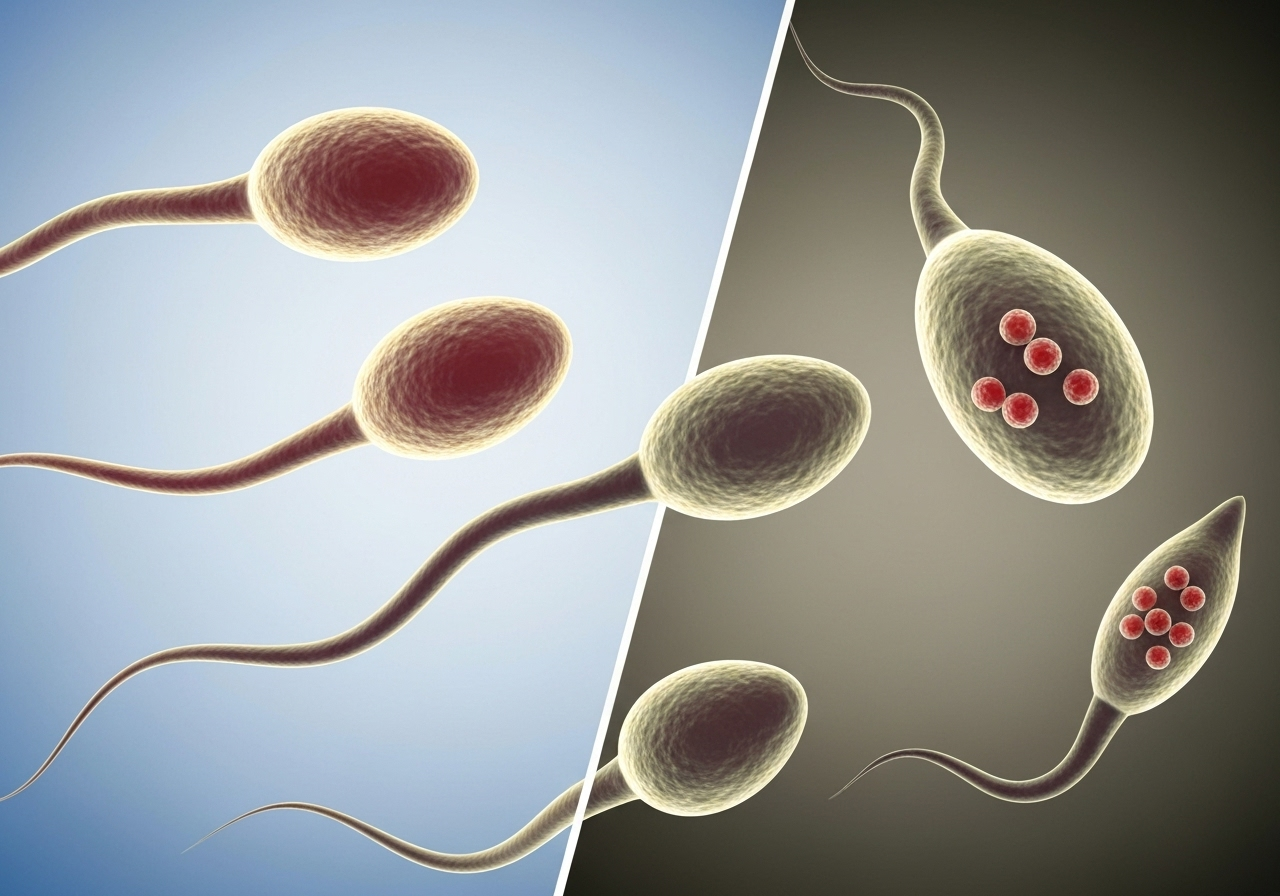
Diagnosing male infertility involves understanding both its symptoms and underlying causes. Often, there are no obvious outward symptoms other than the inability to conceive. The diagnosis relies on semen analysis, which can reveal issues like a low sperm count, poor motility, or abnormal sperm shape. These are the clinical indicators of potential infertility causes.
Problems can originate from the reproductive tract, genetic conditions, or even lifestyle factors. A low sperm concentration is a common finding, but it is just one piece of the puzzle. The following sections will provide more detail on the common symptoms and various causes that impact male fertility.
Common Symptoms Impacting Sperm Quality
When we talk about symptoms of male infertility, we are often referring to the results found during a semen analysis rather than physical signs. These findings provide a direct window into sperm quality and reproductive potential. Issues with sexual intercourse can sometimes be a symptom, but the most concrete evidence comes from the lab.
A comprehensive analysis looks beyond just the low sperm count. It evaluates how sperm move and what they look like, as these factors are critical for fertilization. Problems in the reproductive tract, such as blockages, can also prevent sperm from being ejaculated properly, leading to a diagnosis of infertility.
Key indicators of poor sperm quality found during analysis include:
- Oligospermia (low sperm count)
- Asthenospermia (poor sperm motility)
- Teratospermia (abnormal sperm morphology)
- Azoospermia (complete absence of sperm in the ejaculate)
- Issues with semen volume or consistency
Medical and Genetic Causes of Male Factor Infertility
Beyond what is visible in a standard semen analysis, deeper medical and genetic factors can be at the root of male infertility. These issues can disrupt sperm production or impair sperm function, making it difficult to conceive naturally. In some cases of unexplained infertility, the cause may lie within the sperm’s genetic material.
Genetic testing can reveal chromosomal abnormalities or specific gene mutations that affect fertility. For example, damage to the sperm’s DNA, known as DNA fragmentation, is a significant cause of poor reproductive outcomes. This damage can prevent an embryo from developing properly, even if fertilization occurs.
Understanding these underlying causes is crucial for choosing the right treatment. For severe male infertility linked to genetic factors, advanced procedures like ICSI may be recommended to improve the birth rate. Addressing these medical issues is key to overcoming challenges and achieving a successful pregnancy.
Lifestyle Influences on Sperm Health
Your lifestyle choices can have a significant impact on your sperm health. While not always the primary cause of infertility, certain lifestyle factors can contribute to poor sperm quality by increasing oxidative stress in the body. Oxidative stress occurs when there is an imbalance of damaging molecules called reactive oxygen species (ROS).
These molecules can harm sperm cells, leading to decreased motility, abnormal morphology, and DNA damage. This damage can reduce the overall number of sperm that are healthy enough to fertilize an egg. Even if you have a high sperm count, high levels of oxidative stress can compromise their effectiveness.
Making positive changes can help protect your sperm from this damage. By reducing exposure to factors that cause oxidative stress, you can support your body’s ability to produce healthy, functional sperm and improve your overall reproductive health.
Conventional Semen Analysis Approaches
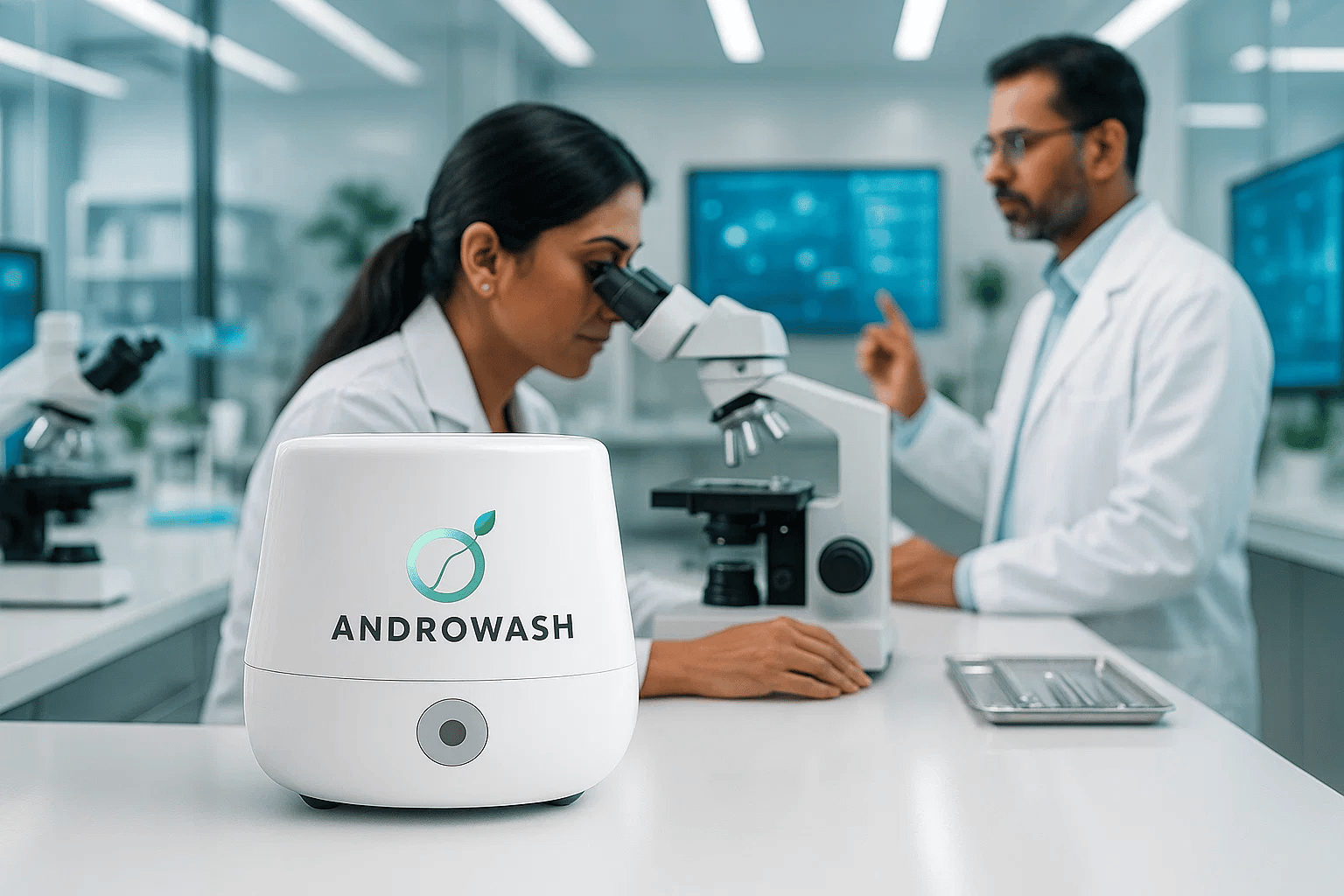
Conventional semen analysis is the foundational diagnostic tool for assessing male fertility. It involves a microscopic examination of a semen sample to evaluate several key parameters. The primary measurements include sperm concentration (the number of sperm per milliliter), sperm motility (the percentage of motile sperm), and sperm morphology (the shape and structure of the sperm).
These basic assessments provide a snapshot of a man’s reproductive health and help guide initial treatment decisions. However, different labs may use slightly different methods, leading to variability in results. Let’s look closer at how these specific parameters are measured.
Measuring Sperm Concentration and Motility
Sperm concentration, or sperm count, is one of the first things checked in a semen analysis. It measures the number of sperm in a given volume of the semen sample. While a higher number is generally better, it is not the only factor that matters. A certain threshold of motile sperm is often needed for IUI to be successful.
Sperm motility is arguably even more important. This parameter assesses the ability of sperm to move effectively. The analysis distinguishes between sperm that are moving and those that are not, and further categorizes the moving ones based on their pattern of movement. Progressive motility, which is forward movement, is crucial for the sperm’s journey to the egg.
Some studies suggest a link between the total motile sperm count after preparation and the probability of conception. Therefore, both concentration and motility are critical metrics for predicting fertility potential and planning treatment.
Morphology Assessment Techniques
Sperm morphology refers to the size and shape of the sperm. For a sperm to be considered morphologically normal, its head, midpiece, and tail must all have a specific structure. Abnormalities in any of these areas can impair the sperm’s ability to swim or to penetrate an egg.
Assessing morphology involves staining a portion of the semen sample and examining the sperm under a high-powered microscope. A trained embryologist evaluates the shape of hundreds of sperm and calculates the percentage of normal forms. A higher percentage of normally shaped sperm is associated with better sperm quality and higher fertility rates.
This assessment helps in measuring sperm health and can influence the choice of ART, as certain procedures can bypass morphology-related issues. Improving the selection of morphologically normal sperm can contribute to a better birth rate.
| Feature | Ideal Characteristic |
|---|---|
| Head | Smooth, oval shape |
| Midpiece | Slender and connected to the head |
| Tail | Single and uncoiled |
| Size | Within normal range |
Viability and Acrosome Evaluation
Beyond just moving, a sperm must be alive and functional to fertilize an egg. Sperm viability testing is used to determine the percentage of live sperm in a sample, which is especially important when motility is very low. This test can distinguish between sperm that are immotile but alive and those that are dead.
Sperm function tests go a step further to assess whether the sperm can perform the tasks needed for fertilization. One of the most critical functions is the ability to bind to and penetrate the egg. This process depends on the integrity of the sperm head, which contains the structures necessary to initiate fertilization.
Evaluating the functional capacity of human sperm is essential in assisted reproduction. Selecting a sperm that is not only motile but also viable and functionally competent is key to achieving a successful pregnancy. These detailed evaluations ensure that only the best-equipped sperm are used for treatment.
Advancements in Semen Evaluation for ART Success
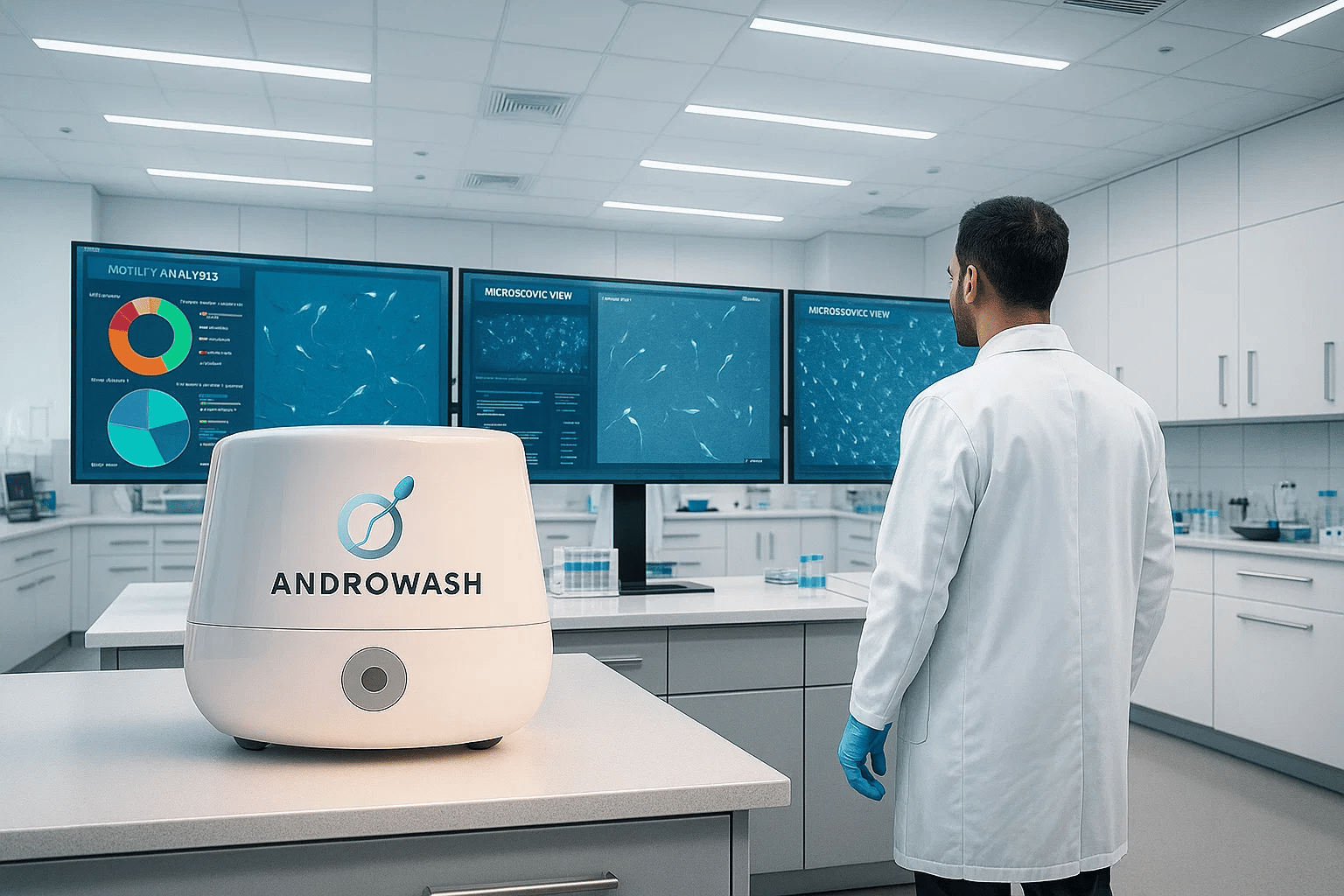
While conventional semen analysis provides a good baseline, it does not tell the whole story. Advancements in semen evaluation are providing a deeper understanding of semen quality and helping to improve ART success rates. These advanced diagnostics look beyond basic counts and motility to assess the functional and genetic health of sperm.
By identifying subtle issues that a standard sperm analysis might miss, clinicians can make more informed decisions about treatment. This leads to better sperm selection, higher quality embryos after fertilization, and improved outcomes following an embryo transfer. The following sections will cover some of these cutting-edge evaluation methods.
Computer-Assisted Semen Analysis Systems
One of the challenges with traditional sperm analysis is its subjectivity. Different technicians might interpret motility or morphology slightly differently. Computer-Assisted Semen Analysis (CASA) technology helps to overcome this by introducing objectivity and standardization to the evaluation process.
These systems use sophisticated software to analyze a video of a semen sample. The technology can track hundreds of sperm simultaneously, providing precise and repeatable measurements of sperm concentration, motility, and velocity. This removes the element of human error and ensures that results are consistent.
By providing highly detailed data on sperm movement patterns, CASA systems offer a more in-depth look at sperm quality than the human eye can provide. This technology represents a significant step forward in making sperm analysis more accurate and reliable for fertility clinics everywhere.
Flow Cytometry and Cytometric Analysis
Flow cytometry is a powerful technology that allows for the rapid analysis of thousands of individual cells. In the context of semen analysis, it can be used to assess various aspects of sperm function and quality on a cell-by-cell basis. This provides a much more detailed picture than bulk sample measurements.
Using fluorescent probes, flow cytometry can measure properties like sperm viability, DNA integrity, and the presence of specific proteins on the sperm surface. For example, it can quickly identify the proportion of sperm with damaged DNA or those undergoing apoptosis (programmed cell death).
This level of detailed cytometric analysis gives clinicians valuable information about the overall health of the sperm population. It helps to identify underlying issues that may not be apparent in a standard analysis, leading to a more precise diagnosis and better-tailored treatment strategies.
Plasma Membrane and Mitochondrial Integrity Analysis
The health of a sperm’s plasma membrane and its mitochondria are critical for its function. The plasma membrane acts as a gatekeeper, and its integrity is essential for the sperm to interact with the egg. Damage to this membrane, often caused by oxidative stress, can render a sperm non-functional.
Mitochondria are the “powerhouses” of the sperm, providing the energy needed for its long journey. The integrity of the mitochondrial genome and its ability to produce energy are directly linked to sperm motility. Damage to mitochondria can lead to a loss of sperm function and poor motility.
Analyzing mitochondrial integrity has become an important part of assessing sperm health. Tests that evaluate both the plasma membrane and mitochondrial function provide a deeper insight into a sperm’s potential for fertilization, helping to select the most robust sperm for ART procedures.
High-Resolution Sperm Tracking Methods
Understanding how a sperm moves is just as important as knowing that it moves. High-resolution sperm tracking methods use advanced imaging and software technology to analyze the specific movement patterns of human sperm in great detail. This goes far beyond a simple assessment of sperm motility.
These systems can measure parameters like swimming speed, linearity of the path, and the frequency of the tail beat. Certain movement patterns, known as hyperactivation, are associated with a sperm’s ability to fertilize an egg. Identifying sperm that exhibit these characteristics can improve selection for ART.
By providing a quantitative analysis of sperm kinematics, this technology offers a more nuanced view of sperm quality. It helps to identify the most vigorous and functionally competent sperm, which are the best candidates for use in fertility treatments.
Sperm DNA Fragmentation Testing in ART
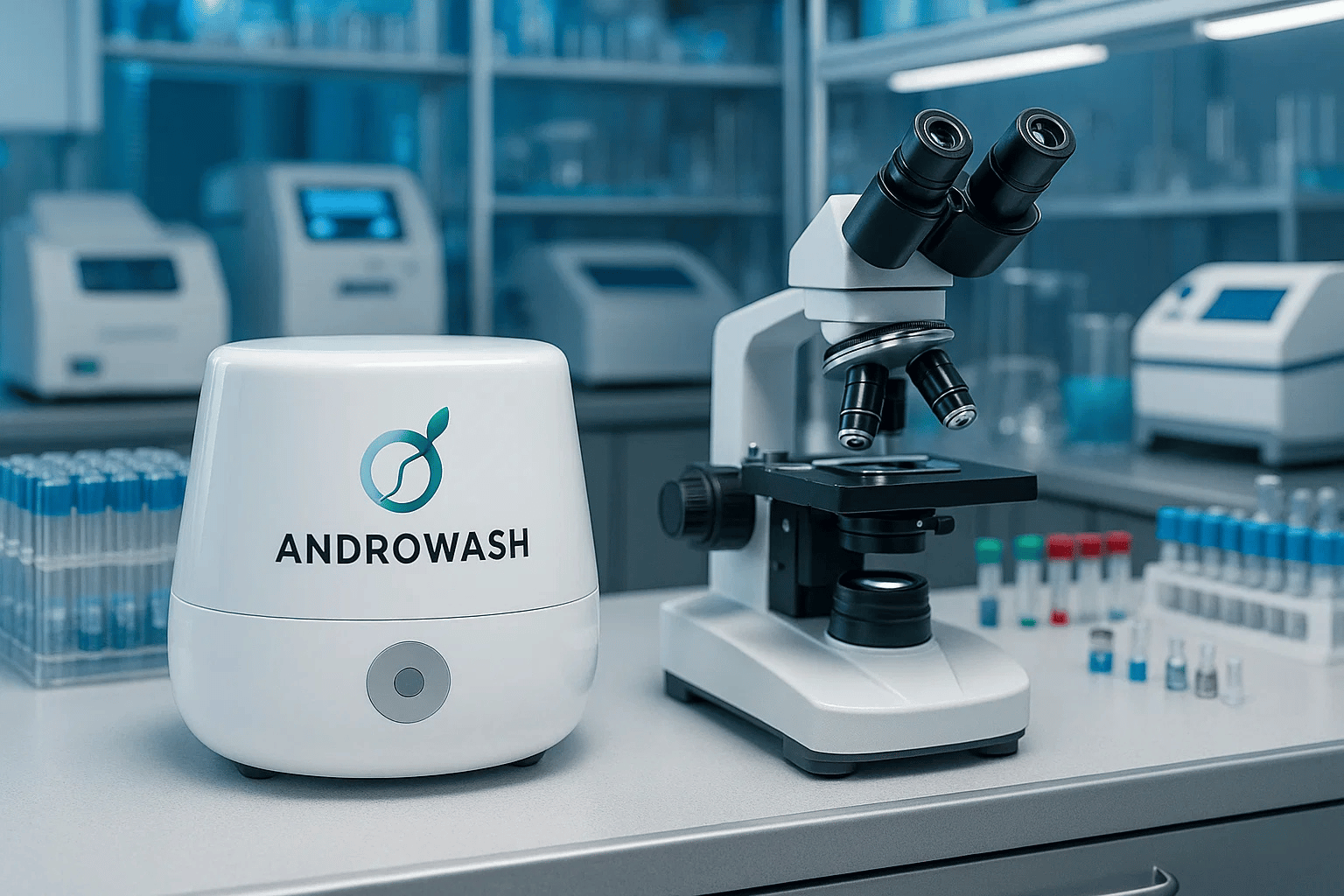
The genetic material inside a sperm is its most important cargo. Sperm DNA fragmentation refers to breaks or damage in the DNA strands within the sperm head. High levels of DNA fragmentation can negatively impact ART outcomes, leading to poor embryo development and lower pregnancy rates. This damage is often caused by oxidative stress from reactive oxygen species.
Testing for sperm DNA integrity is an advanced diagnostic tool that provides crucial information beyond a standard semen analysis. It helps to identify a potential cause for unexplained infertility or recurrent pregnancy loss. Let’s look at the role of this damage and how it is measured.
Role of DNA Fragmentation in Male Factor Infertility
DNA fragmentation is a significant factor in male infertility. While a sperm with damaged DNA may still be able to fertilize an egg, the resulting embryo might not be able to develop properly. This can lead to early pregnancy loss or a failure to implant.
High levels of DNA damage can compromise sperm function in several ways. It is often associated with increased oxidative stress, which can also affect sperm motility and morphology. For many couples experiencing unexplained infertility, high DNA fragmentation may be the hidden cause.
This is why genetic testing for DNA fragmentation is becoming an essential part of the male infertility workup. Identifying this issue allows clinicians to recommend specific interventions, such as using advanced sperm selection techniques or making lifestyle changes to reduce oxidative stress, to improve the chances of a healthy pregnancy.
Popular Sperm DNA Fragmentation Assays
Several laboratory tests, or assays, are available to measure the level of DNA fragmentation in a sperm sample. While they use different methodologies, they all aim to quantify the extent of DNA damage. This information is a valuable addition to a standard semen analysis.
These assays work by subjecting sperm to conditions that reveal underlying DNA breaks. Some tests measure the susceptibility of DNA to denaturation (unwinding), while others directly label the broken DNA strands with fluorescent markers. The results are typically reported as a percentage of sperm with fragmented DNA.
Common principles behind these assays include:
- Assessing the stability of sperm chromatin (the complex of DNA and proteins).
- Directly detecting DNA strand breaks using specific enzymes.
- Measuring the dispersion of chromatin after acid treatment.
- Quantifying the level of DNA damage on a single-sperm basis.
- Evaluating sperm function in relation to its genetic integrity.
Clinical Guidelines for Sperm DNA Fragmentation Testing
While the link between high DNA fragmentation and poor reproductive outcomes is well-supported by evidence, formal clinical guidelines for testing are still evolving. However, many fertility experts recommend sperm DNA fragmentation testing in specific situations to provide a more complete picture of male fertility.
Clinicians may suggest this test for couples with a history of unexplained infertility, recurrent pregnancy loss, or failed IVF/IUI cycles. It can also be useful for men with risk factors for oxidative stress, such as advanced age or certain lifestyle habits. The results of the sperm analysis help guide the next steps in treatment.
For the most current recommendations, clinicians and patients should refer to guidelines published by major reproductive health organizations, such as the American Society for Reproductive Medicine (ASRM). These official websites provide up-to-date information on the clinical use of DNA fragmentation testing in assisted reproduction.
Sperm Preparation Methods Before ART Procedures
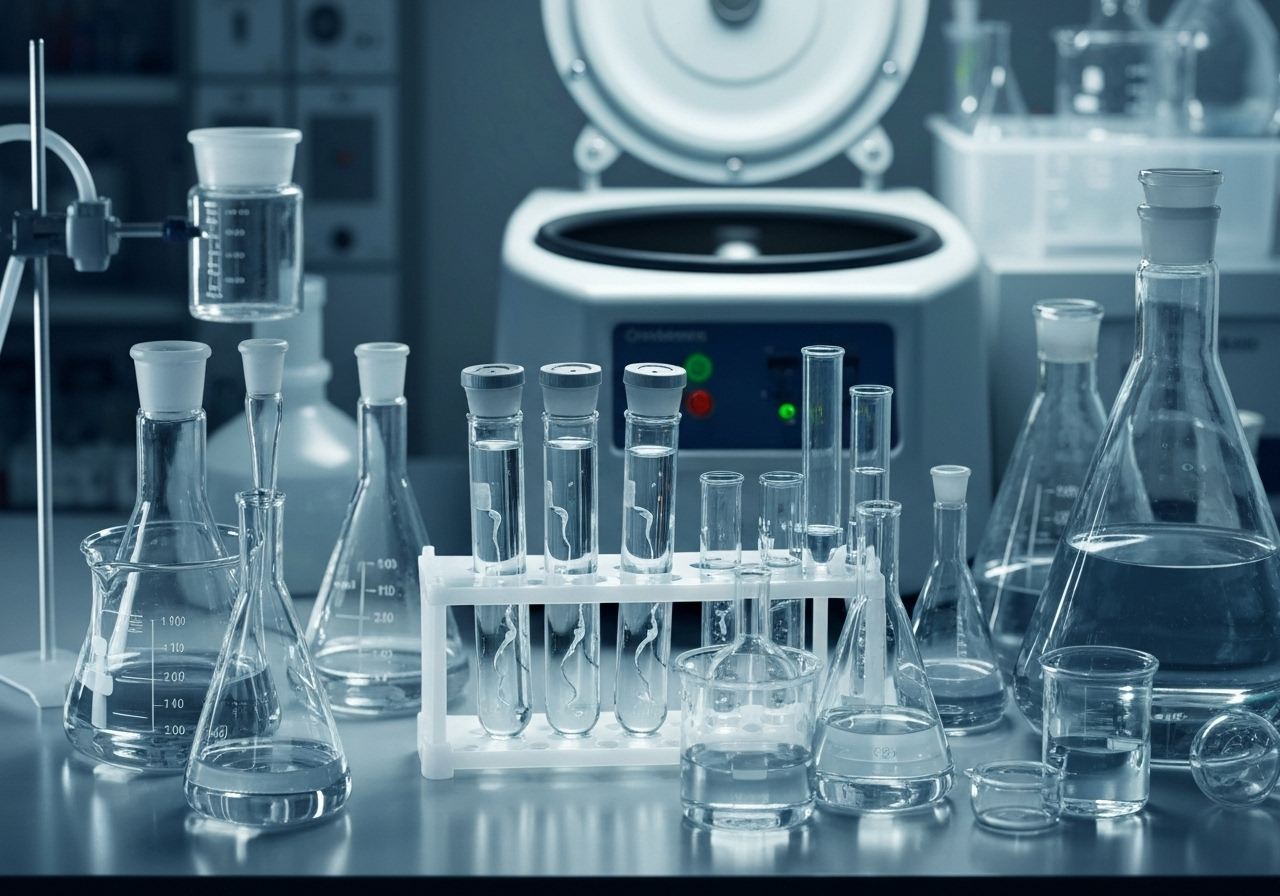
Once a semen sample is collected, it must be prepared before it can be used in assisted reproductive techniques. Sperm preparation, also known as sperm washing, is a critical process that concentrates the healthiest sperm and removes unwanted components from the semen sample. This step is essential for procedures like IUI.
The goal of any sperm selection method is to yield a high number of motile, morphologically normal sperm. The three most common conventional techniques are the swim-up technique, density gradient centrifugation (DGC), and simple wash and centrifugation. Each has its own approach to isolating the best sperm.
Swim-Up Technique for Sperm Selection
The swim-up technique is one of the oldest and most widely used methods for sperm selection. It works by capitalizing on the natural ability of healthy sperm to move. In this procedure, a layer of culture medium is carefully placed over the liquefied semen sample in a test tube.
Only the most motile sperm are able to “swim up” from the semen into the clear medium. After an incubation period, the top layer of medium, now containing the active and healthy human sperm, is collected. This method is effective at isolating sperm with good motility.
The swim-up technique is often preferred for semen samples that are considered relatively normal, as it yields a high-quality, albeit smaller, sperm population. Studies have also suggested that this gentle method may help reduce the rate of DNA fragmentation, further improving sperm quality.
Density Gradient Centrifugation and Its Applications
Density gradient centrifugation (DGC) is another popular sperm preparation method that separates sperm based on their density. This technique is particularly useful for processing semen samples with lower sperm quality, including those with poor motility or high levels of debris.
In this method, the semen sample is layered on top of a column of liquids with increasing densities. When the tube is centrifuged, healthy, dense, and morphologically normal sperm are able to pass through the layers and form a pellet at the bottom. Immature sperm, white blood cells, and debris are trapped in the upper layers.
DGC is highly effective at recovering a large number of motile sperm, making it a preferred technique in many ART labs, especially for male factor infertility. By efficiently separating the best sperm, it helps to prepare a high sperm concentration sample for IUI or IVF.
Challenges Related to Centrifugation Speed and Timing
While centrifugation is a core component of many sperm preparation techniques, the speed and duration of the spin are critical variables that must be carefully controlled. Applying too much centrifugal force can damage the delicate sperm cells, potentially causing membrane and DNA damage.
On the other hand, if the centrifugation speed is too low or the time is too short, the separation will be incomplete. This can result in poor recovery of healthy sperm and contamination of the final sample with debris and dead cells, which can negatively impact sperm quality. Proper sample management is key.
Challenges in optimizing centrifugation include:
- Finding the right balance between effective separation and minimizing sperm damage.
- Standardizing protocols to ensure consistent results across different samples.
- Risk of generating reactive oxygen species (ROS) from excessive force.
- Ensuring lab equipment is properly calibrated for precise speed and timing.
Innovative Microfluidics-Based Sperm Selection
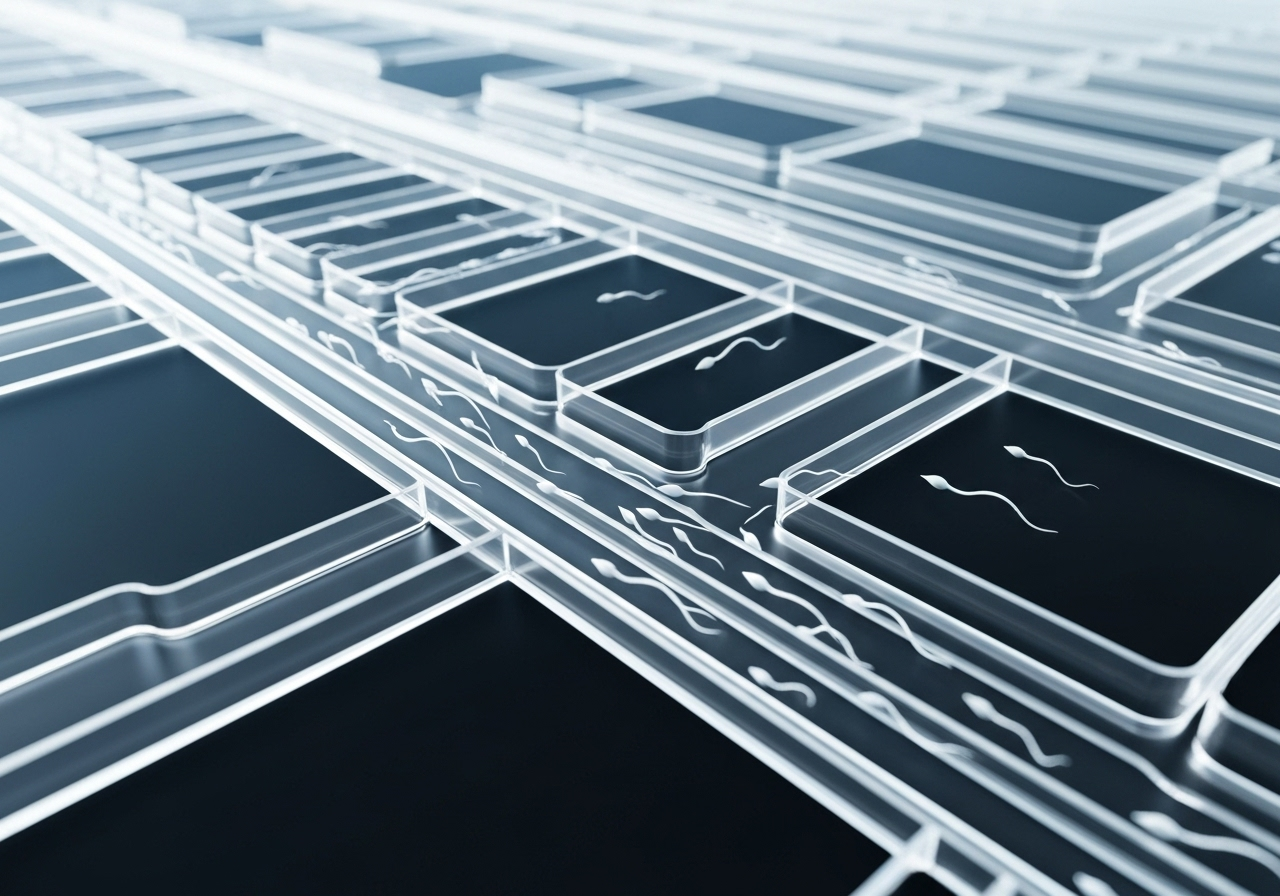
Beyond conventional methods, innovative technologies are emerging to refine the sperm selection process. Microfluidics-based sperm selection is one such advancement that offers a gentler and more automated way to isolate the best sperm. This technology uses tiny channels to sort sperm based on their natural swimming behavior.
By mimicking the natural environment of the female reproductive tract, microfluidics aims to select the most functionally competent sperm without the need for harsh centrifugation. This approach has the potential to improve sperm quality and, consequently, the success rates of assisted reproductive technology. The following sections will explore this technology further.
Principle of Microfluidic Sorting in ART
The principle behind microfluidic sorting is to create a more natural and less stressful environment for sperm selection. These devices contain microscopic channels that guide sperm movement, allowing healthy, motile sperm to swim from an inlet chamber containing the raw semen to an outlet chamber for collection.
This technology leverages the natural tendency of the strongest sperm to swim against a gentle fluid flow, a process known as rheotaxis. Less motile sperm, dead sperm, and debris are left behind. This process avoids the high G-forces of centrifugation, which can cause physical stress and oxidative damage to the sperm.
By sorting sperm based on their intrinsic motility and function, microfluidics offers a highly efficient way to select for the fittest sperm. This innovative technology represents a shift towards biomimetic approaches in ART, aiming to improve the quality of the sperm selected for fertilization.
Benefits for Reducing DNA Damage
One of the most significant potential benefits of microfluidic sperm sorting is its ability to reduce DNA damage. Conventional methods that involve centrifugation can increase the production of reactive oxygen species (ROS), which are a primary cause of DNA fragmentation and oxidative stress in sperm.
By eliminating the need for high-speed spinning, microfluidics provides a much gentler handling process. This minimizes the physical stress on sperm and reduces their exposure to harmful ROS. As a result, the sperm collected using this method tend to have significantly lower levels of DNA damage compared to those prepared with conventional techniques.
Preserving DNA integrity is crucial for successful fertilization and healthy embryo development. By providing a sample of high-quality sperm with minimal DNA damage, microfluidics can enhance sperm function and potentially improve pregnancy outcomes in ART.
Recent Clinical Outcomes in India
Fertility clinics across India are increasingly adopting advanced technologies to improve patient outcomes. As innovative sperm selection methods like microfluidics become more accessible, they are being integrated into assisted reproduction protocols to enhance success rates.
Clinical studies are underway in India to evaluate the effectiveness of these newer techniques compared to traditional methods. The primary goals are to demonstrate improvements in key metrics like pregnancy rates and the live birth rate. The data gathered from these studies will be crucial for establishing new standards of care.
Early findings and expectations from the use of advanced sperm sorting in India include:
- Higher recovery of sperm with intact DNA.
- Improved fertilization rates in IVF and ICSI.
- An increase in the number of high-quality embryos.
- Better clinical pregnancy rates per cycle.
- A potential increase in the overall birth rate for couples undergoing ART.
MACS (Magnetic-Activated Cell Sorting) and Its Impact
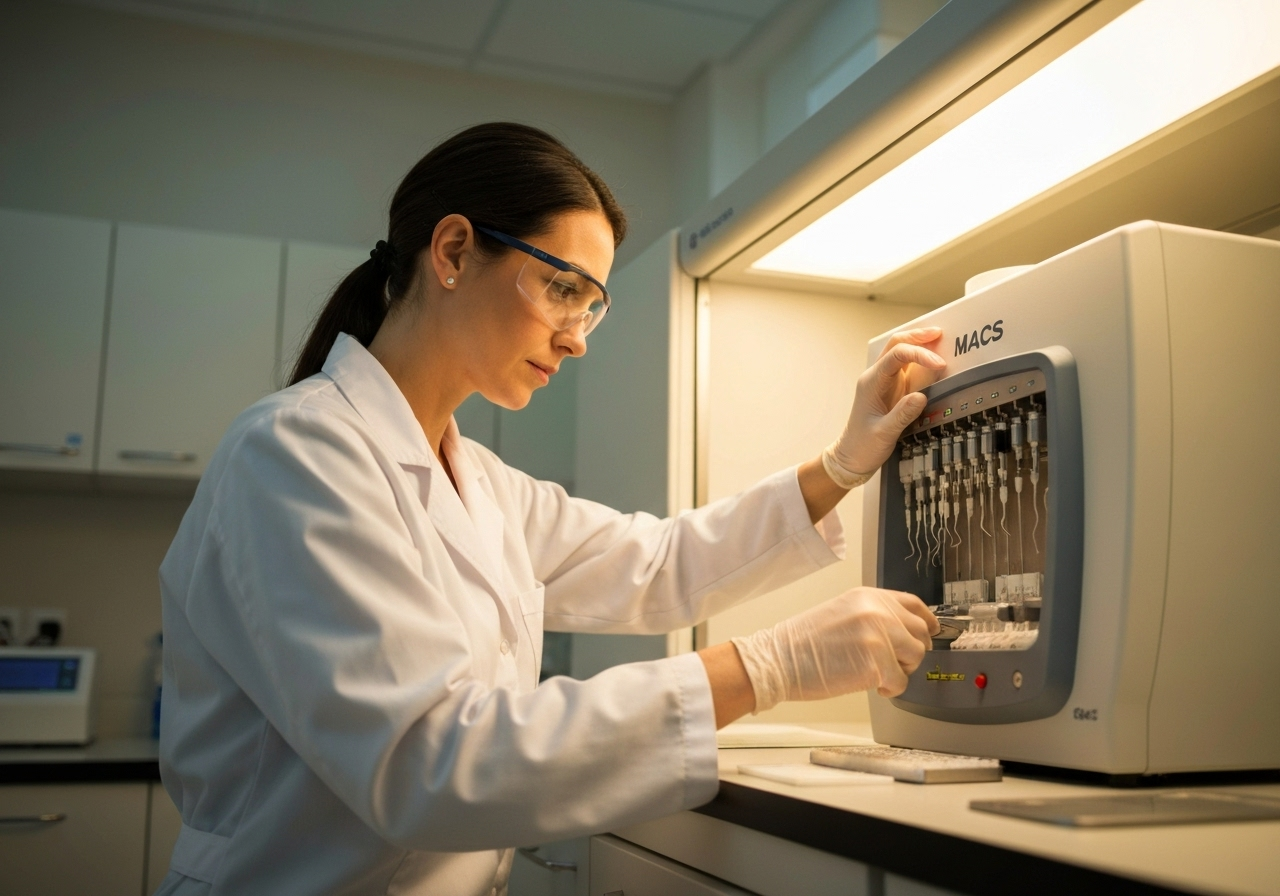
Magnetic-Activated Cell Sorting, or MACS, is another advanced sperm selection technology that targets sperm on a molecular level. This method is designed to remove apoptotic sperm—those that are in the process of dying—from a semen sample. These dying sperm can have damaged DNA and negatively affect overall sperm quality.
By specifically eliminating these unhealthy sperm, MACS yields a population of viable, non-apoptotic sperm that are better suited for assisted reproductive technology. This targeted approach offers a significant improvement over methods that only sort based on motility or density.
How MACS Works for Selecting Healthy Sperm
The MACS technique works by identifying and removing sperm that are starting to undergo apoptosis, or programmed cell death. A key marker of early apoptosis is the presence of a specific molecule, phosphatidylserine, on the outer membrane of the sperm.
In the MACS process, the semen sample is mixed with tiny magnetic nanoparticles that are coated with a protein (Annexin V) that binds specifically to this molecule. When the sample is passed through a gentle magnetic field, the apoptotic sperm attached to the magnetic particles are trapped, allowing the healthy sperm to pass through for collection.
The general steps of the MACS process are:
- Incubation of the sperm sample with Annexin V-coated magnetic beads.
- Binding of the beads to apoptotic sperm.
- Passing the sample through a column placed in a magnetic field.
- Collection of the unlabeled, healthy sperm that flow through the column.
Advantages Over Conventional Preparation Methods
MACS offers several key advantages over conventional sperm preparation methods like swim-up and density gradient centrifugation. While traditional techniques select sperm based on physical characteristics like motility and density, MACS selects them based on their biological health at a molecular level.
This allows for the removal of sperm that may look and move normally but are already in the early stages of cell death and may carry damaged DNA. Conventional techniques are unable to distinguish these sperm from healthy ones. This leads to a final sample with a significantly higher proportion of functionally competent sperm.
By providing a purer population of non-apoptotic sperm, MACS can improve overall sperm quality far beyond what is achievable with conventional sperm selection. This can be particularly beneficial for men with high levels of DNA fragmentation, improving their chances of success with ART.
Implementation in IIUI and IVF Settings
The MACS technique is being implemented in fertility clinics for a range of ART procedures, including intrauterine insemination (IUI) and in vitro fertilization (IVF). It is particularly valuable in cases where poor sperm quality is a known issue, such as high DNA fragmentation or previous failed treatment cycles.
For IVF, and especially for intracytoplasmic sperm injection (ICSI), using MACS-sorted sperm can lead to better outcomes. In ICSI, a single sperm is selected for injection into the egg, so ensuring that the chosen sperm is free from apoptotic markers and DNA damage is critically important for healthy embryo development.
By improving sperm function and quality, MACS helps to enhance fertilization rates and embryo quality. Fertility specialists may recommend this advanced sperm preparation method to give their patients the best possible chance of achieving a successful pregnancy.
Hyaluronic Acid-Based Sperm Selection
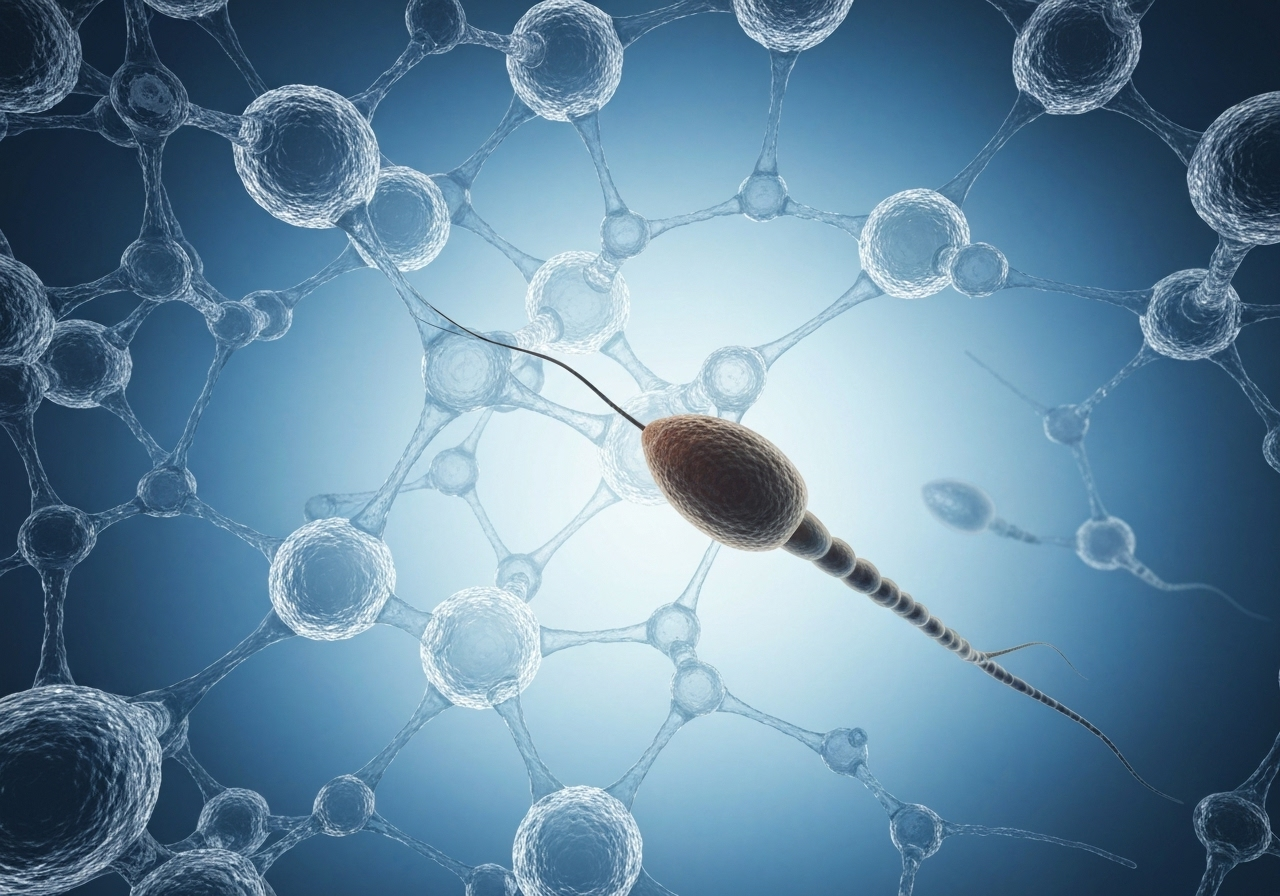
Hyaluronic acid-based sperm selection is another innovative method that mimics a key step in the natural fertilization process. This technique identifies mature, functionally competent sperm by testing their ability to bind to hyaluronic acid (HA), a substance that is a major component of the matrix surrounding the human egg.
Only mature sperm develop the receptors needed to bind to HA. This method, therefore, provides a simple yet powerful way to select for the most biochemically mature sperm, which are more likely to have intact DNA and be capable of successful fertilization.
Mechanism Behind Hyaluronic Acid Binding
The mechanism behind this selection method is elegantly simple and based on natural biology. In the body, a sperm must bind to the hyaluronic acid-rich layer surrounding the egg before it can fertilize it. This sperm binding event is a crucial indicator of sperm maturity and functional competence.
The laboratory technique replicates this process by placing sperm in a dish containing HA. Mature, healthy sperm will bind to the HA, effectively sticking to the dish, while immature or damaged sperm will not. This allows for the easy identification and selection of the bound sperm for use in ART.
This functional sperm analysis is a powerful tool because it directly tests for a key biological capability required for fertilization. A sperm that can bind to hyaluronic acid is more likely to be chromosomally normal and have better overall quality, making it an ideal candidate for procedures like ICSI.
Comparison with Other Sperm Preparation Strategies
Hyaluronic acid-based selection offers a unique approach compared to other sperm preparation strategies. Unlike swim-up, which selects for motility, or density gradient centrifugation, which selects for density, HA binding selects for biochemical maturity and function.
Compared to MACS, which removes dying sperm, HA binding provides a positive selection method—it identifies the “good” sperm rather than just removing the “bad.” It is a direct test of a sperm’s readiness for fertilization. Microfluidics sorts based on swimming behavior, which is another functional test, but HA binding is more specific to the fertilization process itself.
Each of these advanced methods improves upon conventional sperm preparation by adding a layer of functional or biological assessment. The choice of method may depend on the specific fertility issue being addressed, but all aim to improve sperm quality and, ultimately, ART success.
Suitability for Different ART Procedures
Hyaluronic acid-based sperm selection is particularly well-suited for Intracytoplasmic Sperm Injection (ICSI). In an ICSI procedure, an embryologist must choose a single sperm to inject directly into the egg. Making this selection based on visual appearance alone can be challenging.
Using HA binding allows the embryologist to select a sperm that has already proven its biochemical maturity. This is often referred to as PICSI (physiologic ICSI). By choosing a bound sperm, the chances of selecting one with normal chromosomes and low DNA fragmentation are significantly increased, which can improve embryo quality and pregnancy rates.
This technique is suitable for various assisted reproductive techniques, especially in cases where:
- A high degree of precision is needed for single sperm selection (ICSI).
- There is a history of poor embryo development or high sperm DNA fragmentation.
- The goal is to maximize the chances of selecting a functionally competent sperm.
The Role of AI in Sperm Selection during ART
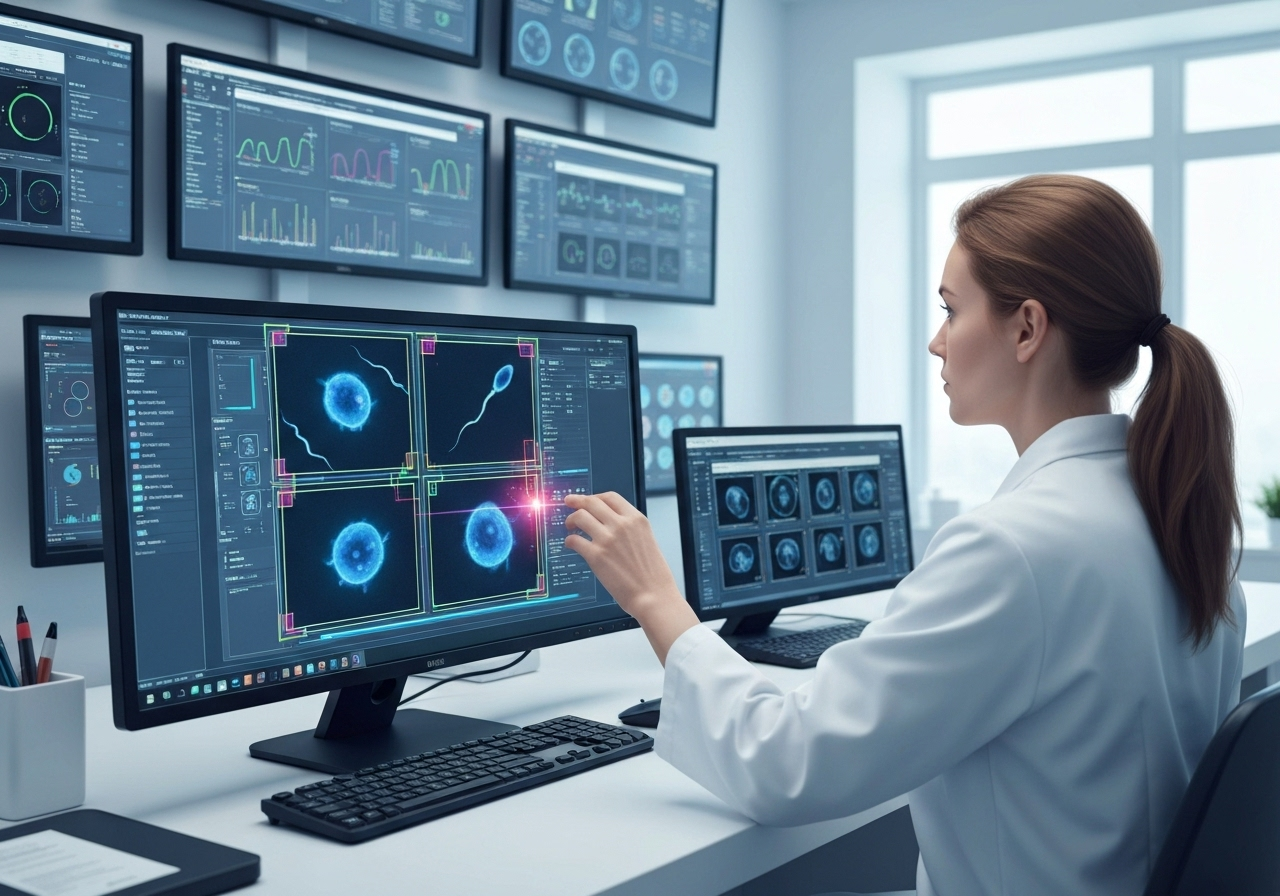
Artificial intelligence (AI) is poised to revolutionize sperm selection by bringing unprecedented accuracy and objectivity to the process. AI algorithms, particularly those based on machine learning, can analyze sperm images and videos with a level of detail and consistency that surpasses the human eye.
This technology can automate sperm image analysis, identify the most promising sperm for ART, and eliminate the subjective variability that exists between different embryologists and clinics. By leveraging the power of AI, fertility clinics can enhance their diagnostic capabilities and improve sperm selection outcomes.
Artificial Intelligence Algorithms for Sperm Image Analysis
Artificial intelligence algorithms can be trained to perform highly sophisticated sperm analysis from digital images or videos. These systems can assess thousands of sperm in a fraction of the time it would take a human, providing a wealth of quantitative data on sperm quality.
Using deep learning, a type of machine learning, these algorithms can learn to identify subtle patterns in sperm morphology and motility that are correlated with successful fertilization. They can track movement with incredible precision and flag even minor structural defects that might be missed by an embryologist.
AI-powered technology can enhance sperm analysis by:
- Providing objective and standardized measurements of motility and morphology.
- Identifying the most viable sperm based on complex learned patterns.
- Ranking sperm based on their predicted potential for success.
- Reducing the time and labor required for manual analysis.
Enhancing Diagnostic Accuracy with Machine Learning
The key to enhancing diagnostic accuracy with machine learning lies in its ability to learn from vast amounts of data. These algorithms are trained on huge datasets containing images of sperm and their corresponding outcomes—whether they led to fertilization, a healthy embryo, or a live birth.
Through this training process, the machine learning model learns to connect specific sperm characteristics to successful outcomes. It can identify complex combinations of features that are predictive of success, something that is nearly impossible for a human to do. This allows the AI to make a highly educated “guess” about which sperm is the best choice for sperm selection.
By removing human subjectivity and leveraging the power of big data, AI-driven sperm analysis can dramatically improve diagnostic accuracy. This leads to more reliable and consistent sperm selection, which is a critical factor in the success of ART.
Real-world Use of AI in ART Clinics in India
The adoption of artificial intelligence in ART clinics in India is a growing trend. Forward-thinking fertility centers are beginning to integrate AI-powered sperm analysis platforms into their laboratory workflows to enhance precision and improve patient outcomes.
This technology helps clinics to standardize their sperm analysis process, ensuring that every patient receives the same high level of diagnostic accuracy. By automating the most time-consuming aspects of semen analysis, AI frees up highly skilled embryologists to focus on other critical tasks in the assisted reproduction process.
As AI technology becomes more accessible and its benefits more widely recognized, its use in Indian fertility clinics is expected to expand rapidly. This will help to elevate the standard of care, improve success rates for IUI and IVF, and give more couples a better chance of building their families.
Androwash and Its Role in IIUI Success Rates
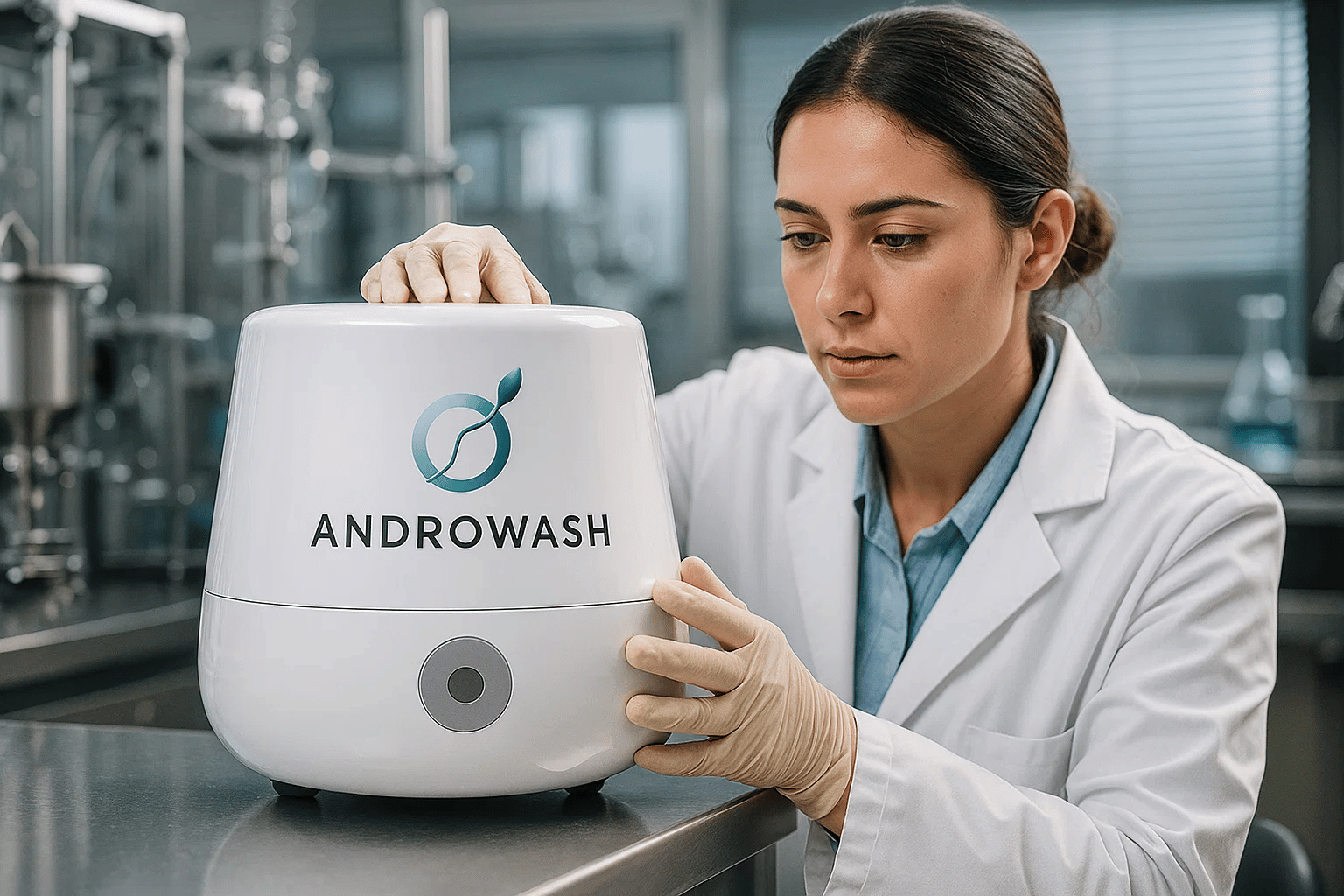
Androwash is a system designed to streamline and standardize the sperm preparation process, particularly for Intrauterine Insemination (IUI). By providing a consistent and optimized method for sperm washing, Androwash aims to improve the quality of the sperm sample used for insemination, which can directly impact IIUI success rates.
This approach helps fertility clinics achieve more reliable and repeatable results compared to manual preparation methods. By ensuring a high-quality sperm sample is prepared every time, systems like Androwash play a crucial role in enhancing the effectiveness of IUI and improving pregnancy rates for patients.
Technical Features of Androwash System
The Androwash system is engineered to address the common challenges of manual sperm preparation. It is typically a closed, sterile system that minimizes the risk of contamination and standardizes the critical steps of the washing and centrifugation process.
The technology is designed to optimize variables like centrifugation speed and timing, which are crucial for separating healthy sperm without causing damage. The system likely uses proprietary media and a controlled environment to protect the semen sample from oxidative stress, ensuring that the final sperm population is as healthy as possible.
By integrating these features into a single, easy-to-use device, the Androwash system provides a robust and reliable solution for sperm preparation. This technology helps to ensure that every semen sample is processed under ideal conditions, leading to consistent, high-quality results.
Steps in the Androwash Sperm Preparation Process
The Androwash sperm preparation process is designed to be simple, efficient, and highly effective. It automates the key steps of sperm washing to ensure that the final sample has a high concentration of motile, functional sperm.
The process begins with loading the raw semen sample into the specialized Androwash device. The system then takes over, performing the necessary washing and separation steps in a controlled manner. This removes debris, dead cells, and seminal plasma, leaving behind a purified sample of the best-quality sperm.
A typical Androwash process would involve these steps:
- Loading the fresh semen sample into the sterile Androwash unit.
- Automated mixing with a specialized washing medium.
- Controlled centrifugation to gently pellet the healthy sperm.
- Removal of the supernatant containing debris and dead cells.
- Collection of the final, concentrated sample of high-quality sperm ready for IUI.
Clinical Data Supporting Androwash Effectiveness
Clinical data is essential for validating the effectiveness of any new technology in reproductive medicine. Studies on systems like Androwash are designed to measure their impact on both sperm quality parameters and, most importantly, clinical outcomes like pregnancy rates and live births.
The goal of these studies is to demonstrate that a standardized, automated system can produce superior results compared to traditional, manual sperm preparation methods. This involves comparing the quality of sperm processed by Androwash to that of sperm processed by conventional techniques. Key metrics include motility, morphology, and DNA integrity.
Ultimately, the most convincing evidence comes from clinical pregnancy rates. Data showing that the use of Androwash leads to a statistically significant increase in successful pregnancies and live births provides the strongest support for its adoption in fertility clinics seeking to optimize their IUI protocols.
Clinical Guidelines for Sperm Diagnosis in ART

Clear clinical guidelines for sperm diagnosis are essential for ensuring that all patients receive a consistent and high standard of care. These guidelines help clinicians navigate the complex process of evaluating male infertility and selecting the most appropriate assisted reproductive techniques.
From basic semen analysis to advanced testing like DNA fragmentation, guidelines provide a framework for a thorough workup. They also help in choosing the right sperm preparation method for the specific ART procedure being performed. The following sections will outline some of these recommended pathways and protocols.
Recommended Evaluation Pathways for Clinicians
For clinicians managing male infertility, a structured evaluation pathway ensures that no important factors are missed. This systematic approach helps to identify the underlying cause of infertility and guides the creation of an effective treatment plan.
The clinical pathway typically begins with a comprehensive patient history and a basic semen analysis. Based on these initial findings, the clinician can decide if further, more advanced testing is warranted. This step-by-step process ensures a thorough and efficient diagnosis.
A recommended clinical pathway for sperm diagnosis might include:
- Initial consultation and collection of a semen sample.
- Standard semen analysis (concentration, motility, morphology).
- If results are abnormal or infertility is unexplained, proceed to advanced testing.
- Consider sperm DNA fragmentation analysis.
- Use all diagnostic data to determine the best sperm preparation method and ART procedure.
Factors Affecting Sperm Selection Decisions
The decision of which sperm selection method to use is influenced by several factors. There is no one-size-fits-all approach; the best method depends on the individual patient’s sperm quality and the specific assisted reproduction procedure being planned.
The results of the initial semen analysis are a primary consideration. A sample with normal parameters might be well-suited for a simple swim-up, while a sample with poor motility and high debris might benefit more from density gradient centrifugation. The total number of motile sperm needed for the procedure also plays a role.
Furthermore, results from advanced diagnostics heavily influence the decision. If a high level of DNA fragmentation is detected, a clinician might opt for an advanced selection technique like MACS or PICSI to ensure the chosen sperm are as healthy as possible. This tailored approach to sperm selection is key to maximizing the chances of success in male fertility treatment.
Protocols for Indian ART Centers
As the field of assisted reproduction grows in India, ART centers are increasingly focused on establishing standardized protocols for sperm diagnosis and preparation. These protocols are vital for ensuring ART compliance, maintaining high-quality standards, and improving patient outcomes for procedures like IUI and IVF.
These protocols often create a tiered approach to sperm diagnosis. All patients undergo a standard semen analysis, and those with abnormal results or specific risk factors are recommended for more advanced testing. This ensures that resources are used efficiently while providing comprehensive care.
By implementing clear, evidence-based protocols, Indian ART centers can enhance their service quality, which helps with patient retention. Standardizing procedures for sperm preparation also leads to more consistent and predictable results, ultimately helping more couples achieve their dream of parenthood.
Comparative Analysis of Sperm Preparation Techniques
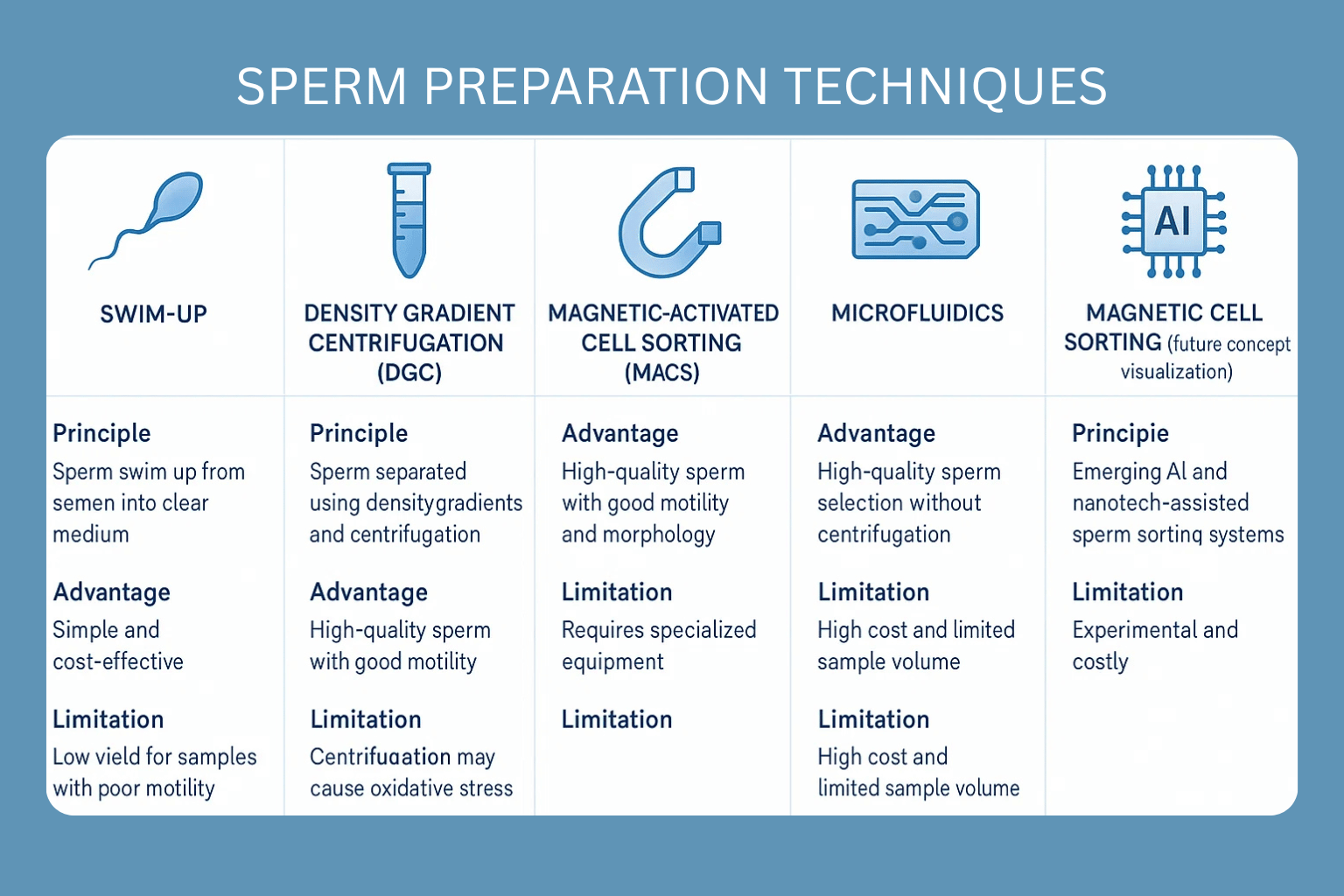
A comparative analysis of sperm preparation techniques is crucial for clinicians to choose the best method for their patients. The main conventional methods, swim-up and density gradient centrifugation (DGC), have been used for decades. However, a major systematic review found that the evidence comparing their effectiveness on live birth rates is of very low quality, making it uncertain if one is superior.
This uncertainty has driven the development of newer techniques like MACS and microfluidics, which select sperm based on biological function rather than just physical properties. These advancements aim to provide a more reliable way to isolate the healthiest sperm.
Efficiency of Preparation Methods: Swim-Up vs. DGC vs. MACS vs. Microfluidics
Modern sperm selection methods are revolutionizing semen preparation for assisted reproductive techniques (ART). Swim-up, density gradient centrifugation (DGC), magnetic-activated cell sorting (MACS), and microfluidics each present unique advantages. For instance, microfluidics excels in isolating motile sperm, increasing the chances of successful intrauterine insemination (IUI). In addition, MACS effectively enhances sperm quality by removing damaged sperm cells, greatly benefiting fertility clinics focused on patient retention. Utilizing tools like Androwash streamlines these processes, ensuring ART compliance and ultimately improving pregnancy outcomes in male fertility treatments. These methodologies represent significant advancements in addressing male fertility challenges.
Impact on Pregnancy and Live Birth Rates
Modern sperm selection methods significantly enhance pregnancy and live birth rates in assisted reproductive techniques (ART). Techniques such as microfluidics and MACS lead to improved semen preparation, allowing for the selection of motile sperm with optimal DNA integrity. These advancements directly impact intrauterine insemination (IUI) success rates, particularly when using systems like Androwash. As fertility clinics adopt these technologies, patient retention increases due to higher overall success rates. This innovative approach not only addresses male fertility challenges but also aligns with ART compliance standards, ensuring more positive outcomes for couples seeking treatment.
Side-By-Side: Cost, Complexity, and Accessibility
Cost, complexity, and accessibility of modern sperm selection methods vary significantly among techniques. Microfluidics stand out due to their efficiency in semen preparation, streamlining the selection of motile sperm for IUI and enhancing pregnancy rates with tools like Androwash. Conversely, techniques such as MACS and AI-based analysis offer advanced sperm quality insights but may involve higher operational costs and require trained personnel. Accessibility remains crucial; fertility clinics must balance advanced technology adoption with patient retention strategies. Ultimately, each method plays a unique role in supporting effective ART compliance and improving reproductive outcomes.
Risks and Limitations in Modern Sperm Selection Methods
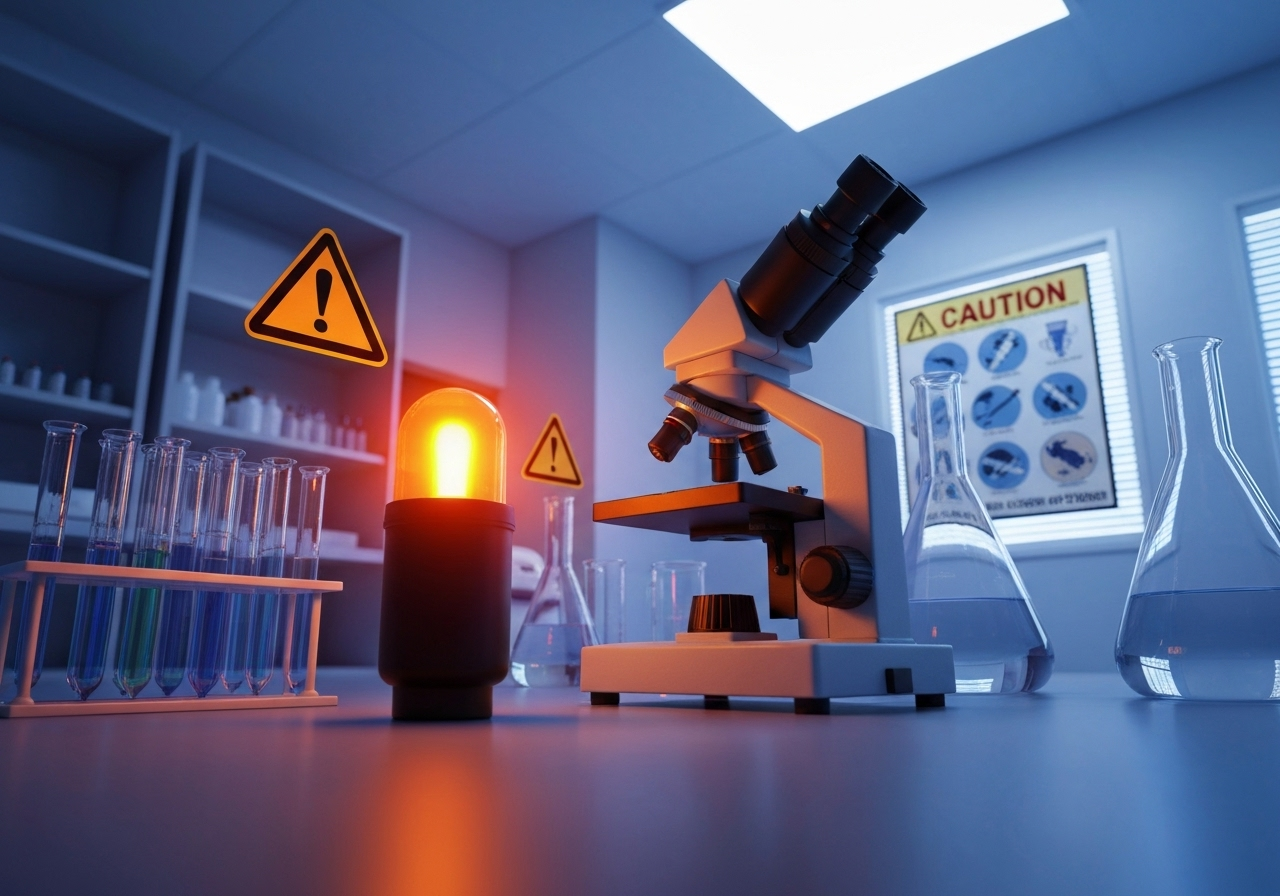
Modern sperm selection methods, including microfluidics and MACS, offer groundbreaking advances in enhancing semen preparation and IUI outcomes. However, these techniques can sometimes face challenges, such as variability in sperm motility and selection accuracy. In addition, the use of AI-based analysis, while innovative, may raise questions about standardization across fertility clinics and ART compliance. Moreover, successful integration of these methods requires ongoing training to ensure patient retention and effective communication. Despite these limitations, tools like Androwash provide a promising avenue for addressing fertility issues through improved sperm function and selection.
Potential Technical Limitations
Developments in sperm selection methods such as microfluidics, MACS, and AI-based analysis represent significant advancements in addressing male fertility challenges. However, technical limitations remain, including the need for high-quality semen preparation and ART compliance within fertility clinics. Variability in equipment performance can impact patient retention, making standardization essential for successful outcomes. Additionally, while tools like Androwash enhance sperm quality, technological constraints may affect IUI success rates. Understanding these limitations allows for continuous improvement in practices, ensuring that sperm diagnostics effectively support enhanced fertility strategies for those seeking home insemination or other assisted reproductive technologies.
Addressing Safety and Reliability Concerns
Modern sperm selection methods such as microfluidics, MACS, and AI-based analysis are revolutionizing fertility treatments, enhancing safety and reliability. These techniques ensure high-quality semen preparation, thus improving outcomes for procedures like home insemination and intrauterine insemination (IUI). By selecting motile sperm with optimal DNA integrity, these advanced methods contribute to ART compliance and increase patient retention in fertility clinics. With tools like Androwash, clinicians can effectively minimize oxidative stress, further boosting the quality of sperm cells used in assisted reproductive techniques. This focus on reliability ultimately enhances overall pregnancy rates and successful live births.
Ongoing Research and Quality Control
Innovations in sperm selection techniques like microfluidics and MACS are revolutionizing treatments for male fertility. Current research underscores the importance of quality control in ART, ensuring that each semen preparation maximizes sperm motility and DNA integrity, crucial for successful embryo transfer in procedures such as IUI. Advanced analytical methods, including AI-based analysis, streamline the identification of optimal sperm, enhancing patient retention at fertility clinics. Ongoing studies aim to refine these methods, aligning with ART compliance standards, and improving home insemination options. Such efforts promise to elevate pregnancy outcomes and live birth rates in assisted reproductive techniques.
Improving ART Outcomes with Innovative Sperm Diagnosis
Modern sperm selection methods significantly enhance outcomes in assisted reproductive technology (ART). Techniques such as microfluidics and MACS facilitate superior semen preparation, isolating motile sperm with high DNA integrity to boost pregnancy rates during intrauterine insemination (IUI). The introduction of AI-based analysis further refines the selection process, ensuring optimal sperm function for procedures like Androwash. These innovations not only improve embryo development but also support ART compliance in fertility clinics, ultimately leading to increased patient retention and higher live birth rates. This strategic approach reflects a commitment to advancing male fertility treatment and supporting hopeful parents.
Effects on Embryo Quality and Development
Modern sperm selection techniques, such as microfluidics and MACS, significantly enhance embryo quality and development. These advanced methods improve semen preparation, resulting in higher-quality sperm for intrauterine insemination (IUI) procedures. Utilizing platforms like Androwash enables fertility clinics to ensure optimal sperm motility and DNA integrity, which are crucial for successful embryo formation. Moreover, these innovative approaches foster ART compliance and can lead to improved pregnancy rates. By focusing on high-quality sperm selection, clinics can enhance patient retention, ultimately transforming the landscape of fertility treatments and empowering couples on their journey toward conception.
ART Procedure Success Rates in Indian Practice
Modern sperm selection methods such as microfluidics and MACS are significantly enhancing the effectiveness of ART procedures in India. The integration of AI-based analysis and tools like Androwash for semen preparation has streamlined processes, contributing to improved IUI and overall fertility success rates. The emphasis on ART compliance has allowed fertility clinics to adhere to best practices, making treatments more reliable and increasing patient retention. These advancements not only optimize sperm quality but also elevate pregnancy outcomes, expanding the options available to couples seeking effective solutions in their journey towards parenthood.
Personalized Treatment Approaches Based on Diagnosis
Modern sperm selection methods, such as microfluidics and MACS, play a crucial role in creating personalized treatment plans for male fertility. These advanced techniques enhance semen preparation, ensuring higher quality sperm, which is fundamental for successful home insemination and intrauterine insemination (IUI). Integrating AI-based analysis with traditional approaches allows fertility clinics to tailor interventions to individual patient needs, thereby improving ART compliance and boosting patient retention. By focusing on sperm function and overall health, these personalized strategies can significantly enhance pregnancy outcomes and support couples in their journey toward parenthood.
Future Directions and Emerging Technologies
Modern sperm selection methods are reshaping the landscape of male fertility treatments. Techniques such as microfluidics and MACS enhance semen preparation, allowing for the identification of motile sperm with high genetic integrity. With the integration of AI-based analysis, fertility clinics can improve patient retention by offering precise assessments of sperm quality, ultimately resulting in better IUI success rates. Innovations like Androwash optimize home insemination protocols, ensuring compliance with ART standards. These advancements signify a transformative phase in reproductive health, promising improved pregnancy outcomes for couples facing fertility challenges.
Next-Generation AI in Sperm Selection
Advancements in sperm selection have been significantly impacted by next-generation AI technologies, enhancing the effectiveness of home insemination and intrauterine insemination (IUI). Using tools like Androwash, which incorporates innovative sperm preparation techniques, fertility clinics can improve semen quality and optimize sperm function. AI-based analysis enables rapid identification of motile sperm, essential for successful ART compliance and improved pregnancy outcomes. This modern approach not only streamlines the sperm selection process but also increases patient retention by providing tailored and efficient treatment options to address male fertility challenges. These advancements promise a brighter future for couples seeking assisted reproductive techniques.
Integration of Genomic Data in Sperm Diagnosis
Genomic data integration offers transformative potential in sperm diagnosis, enhancing the efficacy of assisted reproductive technologies (ART). Techniques such as microfluidics and magnetic-activated cell sorting (MACS) facilitate precise selection of sperm based on genetic profiles, significantly improving semen preparation. The application of AI-based analysis in clinics can lead to higher success rates in intrauterine insemination (IUI) and informed decision-making for patients. By employing genomic screening tools like Androwash, fertility clinics can optimize sperm quality and bolster patient retention, ultimately contributing to better pregnancy outcomes and healthier embryos in the ART process.
New Frontiers in Non-Invasive Sperm Assessment
Modern advancements in sperm selection methods are paving the way for improved male fertility treatments. Techniques such as microfluidics, MACS, and AI-based analysis facilitate refined semen preparation, enhancing the quality of motile sperm used in IUI. With devices like Androwash, fertility clinics can offer non-invasive assessment options that not only boost patient retention but also ensure ART compliance. By focusing on standardized protocols and preserving sperm integrity, these innovative approaches contribute to higher success rates in intrauterine insemination, ultimately leading to more favorable pregnancy outcomes for couples experiencing fertility challenges.
Frequently Asked Questions (FAQ)
Modern sperm selection methods, such as microfluidics, MACS, and AI-based analysis, significantly enhance treatments for male fertility issues. With products like Androwash, semen preparation has improved, leading to higher success rates in intrauterine insemination (IUI). These advances help fertility clinics streamline their processes, ensuring ART compliance and better patient retention. Patients benefit from these cutting-edge techniques, as they promote optimal sperm quality and increase the likelihood of conception. Understanding these methods can empower individuals seeking home insemination or professional IUI services to make informed reproductive choices and achieve their family planning goals.
What are the leading sperm preparation methods used in ART?
The leading sperm preparation methods in ART include swim-up, density gradient centrifugation (DGC), magnetic-activated cell sorting (MACS), and microfluidics. Each technique varies in efficiency, complexity, and cost, influencing the selection of viable sperm for successful fertilization and pregnancy outcomes.
How does sperm DNA fragmentation affect ART success rates?
Sperm DNA fragmentation negatively impacts ART success rates by reducing embryo quality and increasing miscarriage rates. High fragmentation levels are associated with lower fertilization, implantation, and clinical pregnancy rates, highlighting the importance of assessing DNA integrity in optimizing fertility treatment outcomes.
What is the role of AI in sperm selection and diagnosis for fertility treatment?
AI enhances sperm selection and diagnosis by analyzing sperm characteristics more efficiently than traditional methods. It assists in identifying optimal sperm for fertilization, predicting success rates, and personalizing treatment plans, ultimately improving outcomes in fertility treatments.
What are the latest advancements in sperm diagnosis for assisted reproductive technology (ART)?
Recent advancements in sperm diagnosis for ART include the use of microfluidics for improved sperm isolation, AI-driven selection processes to enhance accuracy, and non-invasive techniques that assess sperm quality without compromising viability. These innovations significantly contribute to higher success rates in fertility treatments.
How does innovative sperm diagnosis impact the success rates of ART procedures?
Innovative sperm diagnosis enhances ART success rates by improving sperm selection and increasing embryo viability. Techniques like microfluidics and AI-driven analyses ensure higher-quality sperm, ultimately leading to better pregnancy outcomes and healthier live births in fertility treatments.
What are some common methods used in sperm analysis and how do they differ?
Common methods for sperm analysis include swim-up, density gradient centrifugation (DGC), magnetic-activated cell sorting (MACS), and microfluidics. Each method varies in complexity, efficiency, and effectiveness in isolating motile sperm for assisted reproductive technologies (ART), impacting overall success rates differently.
Are there any risks or ethical considerations associated with advanced sperm diagnostic techniques?
Advanced sperm diagnostic techniques may pose risks such as potential misdiagnosis, privacy concerns regarding genetic data, and ethical dilemmas surrounding selective practices. Clinicians must navigate these issues while ensuring informed consent and prioritizing patient welfare in fertility treatments.
Key Recommendations for Clinicians and Patients
Modern sperm selection methods, such as microfluidics and MACS, are essential for enhancing ART compliance in fertility clinics. Clinicians should adopt these advanced techniques to ensure optimal semen preparation and improve success rates in intrauterine insemination (IUI). For patients considering home insemination methods, guidance on selecting reputable fertility clinics that employ innovative sperm analyses like Androwash is crucial. Increased patient retention hinges on a transparent communication of treatment options and expected outcomes. Ultimately, staying informed about evolving technologies in sperm diagnosis can empower both clinicians and patients in the pursuit of effective fertility solutions.
Best Practice Summaries for Sperm Preparation
Efficient sperm preparation is essential for improving outcomes in assisted reproductive techniques. Advanced methods such as microfluidics and MACS provide superior semen preparation by enhancing sperm quality and selection, leading to higher pregnancy rates. Utilizing AI-based analysis in techniques like Androwash allows for precise identification of motile sperm, optimizing the chances of successful intrauterine insemination (IUI). Fertility clinics adopting these best practices can significantly improve ART compliance and elevate patient retention by ensuring that couples receive the highest standard of care. Emphasizing cutting-edge sperm selection methods fosters trust and enhances the overall fertility treatment experience.
Patient Counseling and Decision-Making Tips
Optimizing success in ART involves clear and concise patient counseling. Highlighting the role of advanced methods such as Androwash can empower patients by improving semen preparation for IUI, ultimately enhancing pregnancy rates. Discussing these innovative techniques fosters informed decision-making, allowing couples to choose the best approach based on their unique circumstances. Encouraging open dialogue and addressing concerns can enhance patient retention in fertility clinics. Educating patients about compliance with ART protocols ensures an understanding of how factors like sperm quality and selection methods influence treatment outcomes, ultimately aiding in their fertility journey.
Optimizing Success with Advanced Diagnostics
Modern sperm selection techniques, such as microfluidics, MACS, and AI-based analysis, are revolutionizing male fertility treatment and enhancing IUI success rates. Utilizing innovative products like Androwash, clinics can significantly improve semen preparation, increasing motile sperm quantity and quality for effective home insemination efforts. Advanced diagnostics not only streamline the ART compliance process for fertility clinics but also boost patient retention through superior outcomes. These methods allow for precise sperm analysis, ensuring that only the best candidates are used during intrauterine insemination, ultimately leading to improved pregnancy and live birth rates.
Checklist for ART Centers in India Implementing Innovative Sperm Diagnosis
Implementing innovative sperm diagnosis in ART centers necessitates a comprehensive checklist. Start with updating the necessary equipment for advanced semen preparation techniques such as microfluidics and MACS. Ensure staff are trained on the latest AI-based analysis methods to enhance sperm selection. Focus on ART compliance by adhering to the best practices set forth by fertility clinics and the World Health Organization. Additionally, consider integrating home insemination kits for increased patient retention. Regularly evaluate the efficacy of new methods in improving IUI success rates, ensuring a conducive environment for both clinical outcomes and patient trust.
Essential Equipment, Training, and Compliance Steps
Modern sperm selection methods require specific equipment and comprehensive training for effective implementation. Essential tools like microfluidic devices and MACS systems enable precise semen preparation, enhancing overall sperm quality and concentration. Additionally, utilizing AI-based analysis aligns with ART compliance, ensuring standardized practices in fertility clinics. Training programs must focus on optimizing the use of technologies like Androwash to bolster home insemination efforts and improve IUI success rates. Compliance with established protocols not only elevates patient retention but also fosters a reliable environment for male fertility treatment, ultimately leading to better pregnancy outcomes.
Conclusion
Contemporary sperm selection methods are reshaping the landscape of male fertility treatments. Techniques like microfluidics, MACS, and AI-based analysis refine semen preparation, ensuring better selection of motile sperm. Notably, Androwash plays a crucial role in enhancing the viability of sperm cells during IUI procedures. Improved sperm quality translates to higher pregnancy rates and live births. With a firm focus on ART compliance, fertility clinics can bolster patient retention by providing advanced solutions that cater to individual needs. The continued evolution of sperm analysis techniques symbolizes a significant leap forward in addressing male fertility challenges.

